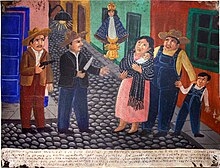
A temple is a building reserved for spiritual rituals and activities such as prayer and sacrifice. Religions which erect temples include Christianity, Hinduism, Buddhism, Sikhism, Jainism, Islam, Judaism, Zoroastrianism, the Baha'i Faith, Taoism, Shinto, Confucianism, and ancient religions such as the Ancient Egyptian religion and the Ancient Greek religion.

In Spain, music has a long history. It has played an important role in the development of Western music, and has greatly influenced Latin American music. Spanish music is often associated with traditional styles such as flamenco and classical guitar. While these forms of music are common, there are many different traditional musical and dance styles across the regions. For example, music from the north-west regions is heavily reliant on bagpipes, the jota is widespread in the centre and north of the country, and flamenco originated in the south. Spanish music played a notable part in the early developments of western classical music, from the 15th through the early 17th century. The breadth of musical innovation can be seen in composers like Tomás Luis de Victoria, styles like the zarzuela of Spanish opera, the ballet of Manuel de Falla, and the classical guitar music of Francisco Tárrega. Nowadays commercial pop music dominates.
Cult is the care owed to deities and temples, shrines, or churches. Cult is embodied in ritual and ceremony. Its present or former presence is made concrete in temples, shrines and churches, and cult images, including votive offerings at votive sites.
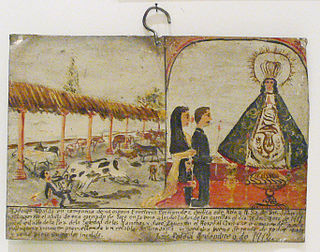
An ex-voto is a votive offering to a saint or to a divinity; the term is usually restricted to Christian examples. It is given in fulfillment of a vow or in gratitude or devotion.

Nuestra Señora de la Santa Muerte, often shortened to Santa Muerte, is a cult image, female deity, and folk saint in folk Catholicism and Mexican Neopaganism. A personification of death, she is associated with healing, protection, and safe delivery to the afterlife by her devotees. Despite condemnation by leaders of the Catholic Church, and more recently evangelical movements, her following has become increasingly prominent since the turn of the 21st century.
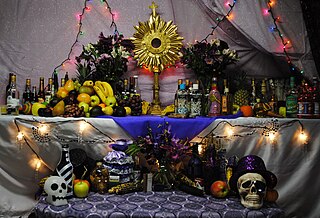
Folk Catholicism can be broadly described as various ethnic expressions and practices of Catholicism intermingled with aspects of folk religion. Practices have varied from place to place, and may at times contradict the official doctrines and practices of the Roman Catholic Church as well as overall Christianity.

A votive candle or prayer candle is a small candle, typically white or beeswax yellow, intended to be burnt as a votive offering in an act of Christian prayer, especially within the Anglican, Lutheran, and Roman Catholic Christian denominations, among others. In Christianity, votive candles are commonplace in many churches, as well as home altars, and symbolize the "prayers the worshipper is offering for him or herself, or for other people." The size of a votive candle is often two inches tall by one and a half inches diameter, although other votive candles can be significantly taller and wider. In other religions, such as Hinduism and Buddhism, similar offerings exist, which include diyas and butter lamps.

A novena is an ancient tradition of devotional praying in Christianity, consisting of private or public prayers repeated for nine successive days or weeks. The nine days between the Feast of the Ascension and Pentecost, when the disciples gathered in the upper room and devoted themselves to prayer, is often considered to be the first novena.
The ordinary, in Roman Catholic and other Western Christian liturgies, refers to the part of the Mass or of the canonical hours that is reasonably constant without regard to the date on which the service is performed. It is contrasted to the proper, which is that part of these liturgies that varies according to the date, either representing an observance within the liturgical year, or of a particular saint or significant event, or to the common which contains those parts that are common to an entire category of saints such as apostles or martyrs.
Nichos are a type of folk art popular throughout Central and South America, often devotional but sometimes merely quirky. Resembling dioramas, they are made from common household objects and craft material and traditionally combine elements from Roman Catholicism, mestizo spirituality, and popular culture. Nicho objects have different names in different places: they may be called retablo or have local names. Peruvian Retablos are a style that encompasses several different portable forms not discussed here.

A retablo is a devotional painting, especially a small popular or folk art one using iconography derived from traditional Catholic church art. More generally retablo is also the Spanish term for a retable or reredos above an altar, whether a large altarpiece painting or an elaborate wooden structure with sculptures. Typically this includes painting, sculpture or a combination of the two, and an elaborate framework enclosing it. The Latin etymology of the Spanish word means "board behind". Aside from being found behind the altar, "similar ornamental structures are built and carved over facades and doorways", called overdoors.
Most of Latin America is predominantly Catholic and miracles have a deep historical tradition in Catholic theology. To some, miracles would be considered fate or a lucky break, but to Catholics "A miracle is a supernaturally (divinely) caused event, an event (ordinarily) different from what would have occurred in the normal ("natural") course of events."
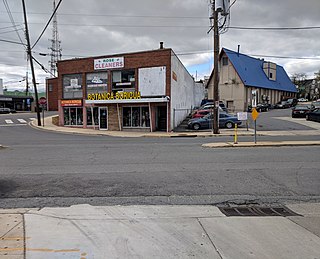
A botánica is a religious goods store. The name botánica is Spanish and translates as "botany" or "plant store," referring to these establishments' function as dispensaries of medicinal herbs. Botánicas are common in many Hispanic American countries and Latino communities around the world. Such establishments sell folk medicine, herbs, candles, and statues for Saints and popular gods. They also carry oils, incense, perfumes, and books. Such stores have become increasingly popular in the United States as the Latino communities they serve have grown in that country. A botánica is a site of healing and support, such that one owner says they are a "place of mysteries" due to the metaphysical appreciation of mystery as a synonym for spirit and divinity.

A God's eye is a spiritual and votive object made by weaving a design out of yarn upon a wooden cross. Often several colors are used. They are commonly found in Mexican, Peruvian people and Latin American communities, among both Indigenous and Catholic peoples.
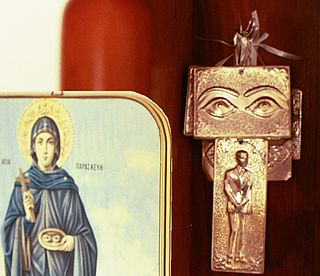
Tama are a form of votive offering or ex-voto used in the Eastern Orthodox Churches, particularly the Greek Orthodox Church. Tamata are usually small metal plaques, which may be of base or precious metal, usually with an embossed image symbolizing the subject of prayer for which the plaque is offered.

An amulet, also known as a good luck charm or phylactery, is an object believed to confer protection upon its possessor. The word "amulet" comes from the Latin word amuletum, which Pliny's Natural History describes as "an object that protects a person from trouble". Anything can function as an amulet; items commonly so used include statues, coins, drawings, plant parts, animal parts, and written words.

Folk saints are dead people or other spiritually powerful entities venerated as saints, but not officially canonized. Since they are saints of the "folk", or the populus, they are also called popular saints. Like officially recognized saints, folk saints are considered intercessors with God, but many are also understood to act directly in the lives of their devotees.
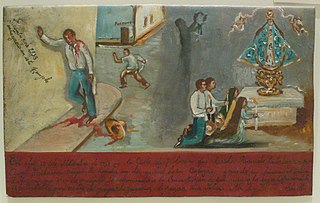
Votive paintings in Mexico go by several names in Spanish such as “ex voto,” “retablo” or “lámina,” which refer to their purpose, place often found, or material from which they are traditionally made respectively. The painting of religious images to give thanks for a miracle or favour received in this country is part of a long tradition of such in the world. The offering of such items has more immediate precedence in both the Mesoamerican and European lines of Mexican culture, but the form that most votive paintings take from the colonial period to the present was brought to Mexico by the Spanish. As in Europe, votive paintings began as static images of saints or other religious figures which were then donated to a church. Later, narrative images, telling the personal story of a miracle or favor received appeared. These paintings were first produced by the wealthy and often on canvas; however, as sheets of tin became affordable, lower classes began to have these painted on this medium. The narrative version on metal sheets is now the traditional and representative form of votive paintings, although modern works can be executed on paper or any other medium.
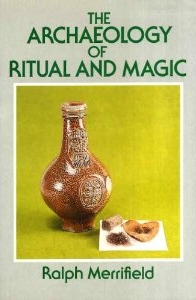
The Archaeology of Ritual and Magic is an archaeological study of the material evidence for ritual and magical practices in Europe, containing a particular emphasis on London and South East England. It was written by the English archaeologist Ralph Merrifield, the former deputy director of the Museum of London, and first published by B.T. Batsford in 1987.
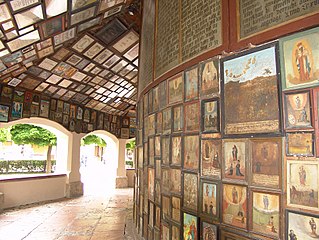
A votive offering or votive deposit is one or more objects displayed or deposited, without the intention of recovery or use, in a sacred place for religious purposes. Such items are a feature of modern and ancient societies and are generally made in order to gain favor with supernatural forces.

